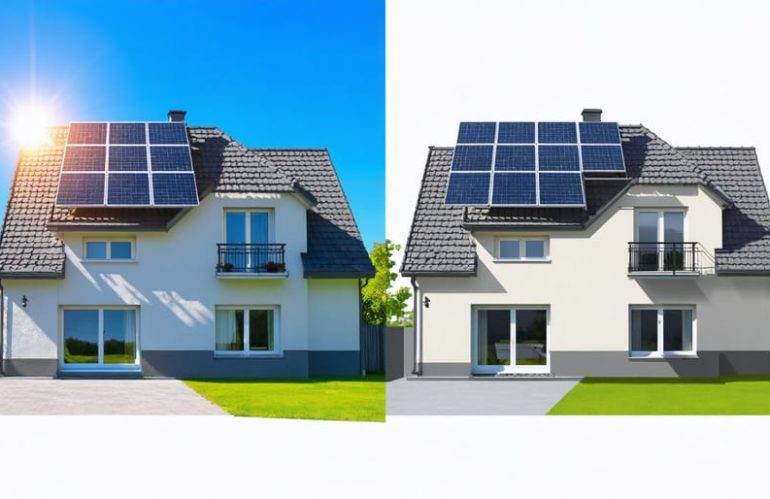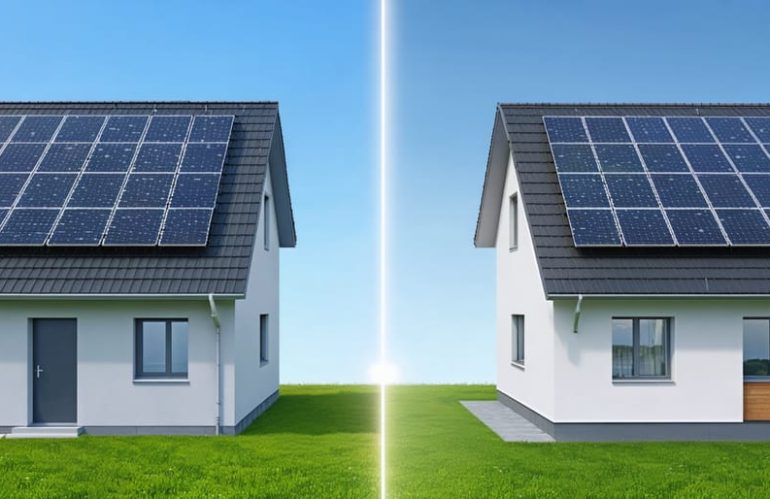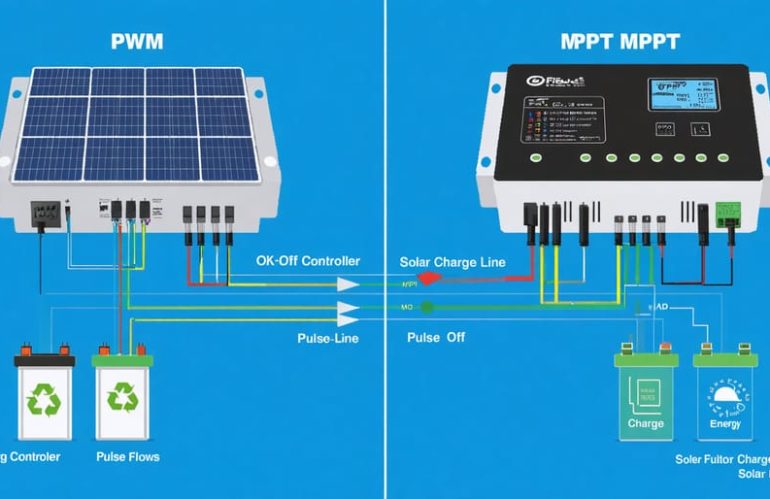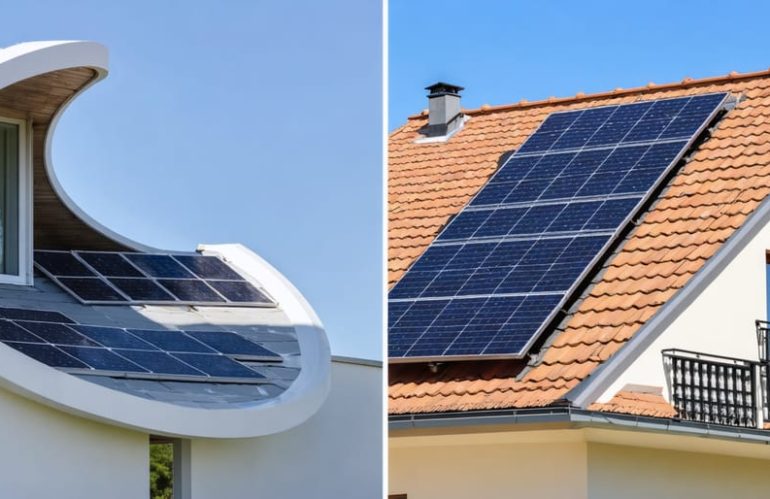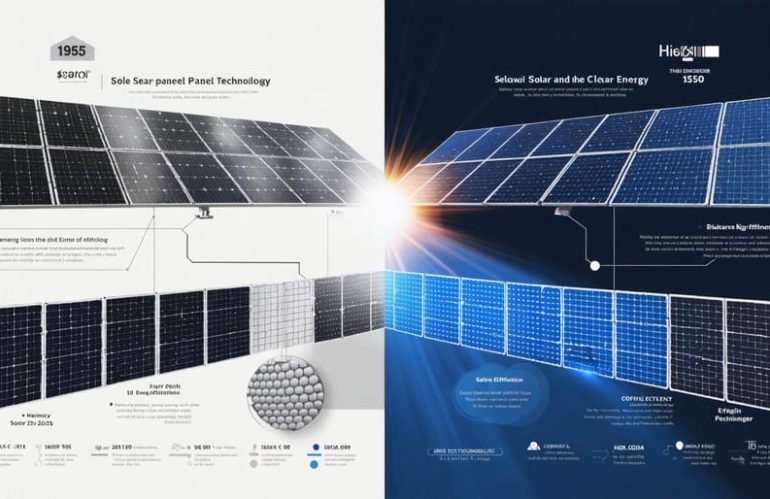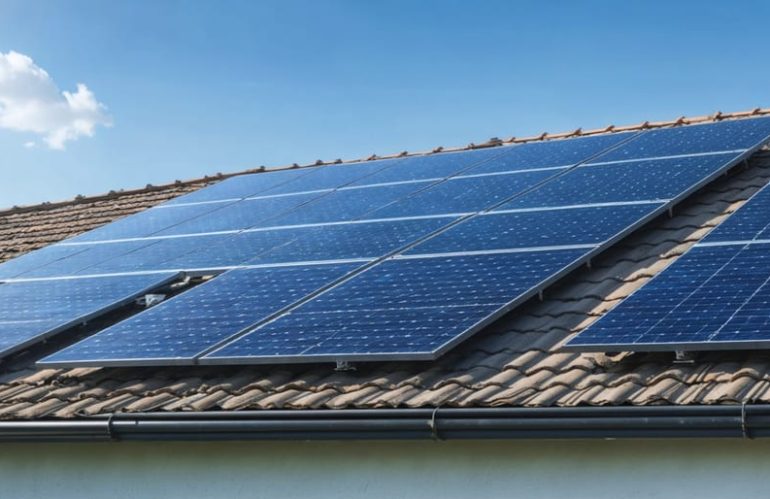Thin-film solar technology represents a groundbreaking shift in renewable energy, offering unprecedented flexibility and installation options that traditional silicon panels simply can’t match. While conventional panels typically achieve 15-20% efficiency, modern thin-film solutions have made remarkable strides, now reaching up to 13-15% efficiency while requiring significantly less material and manufacturing energy. This emerging technology combines ultra-slim profiles—100 times thinner than standard silicon panels—with remarkable adaptability to various surfaces and lighting conditions, making it particularly attractive for …
Category: Product Comparisons and Analysis
Comparative analysis of different solar technologies and products
Solar Tiles vs Panels: Which Roof Solution Actually Saves You More?
The future of solar energy stands at a crossroads between two innovative solar roofing options: traditional panels and integrated tiles. While both harness the sun’s power to slash electricity bills and reduce carbon footprints, they offer distinctly different approaches to home solar installation. Solar panels remain the tried-and-true choice, dominating the market with their proven efficiency and cost-effectiveness. Solar tiles, championed by companies like Tesla, promise seamless roof …
Solar Freedom or Grid Connection? Make the Smart Choice for Your Home
Powering your home with solar energy presents two distinct paths: off-grid independence or grid-tied convenience. While both systems harness the sun’s energy, they serve fundamentally different lifestyle needs and investment goals. Off-grid systems offer complete energy autonomy through battery storage and backup systems, enabling homeowners to thrive beyond utility infrastructure. Grid-tied installations, conversely, maintain a connection to public utilities, allowing seamless power exchange and often lower initial costs. As energy costs rise and climate concerns grow, understanding these options has become crucial for homeowners …
PWM vs MPPT Solar Controllers: Which Actually Saves You More Money?
Choosing between PWM and MPPT solar charge controllers can significantly impact your solar system’s efficiency and your energy savings. While both technologies regulate voltage between solar panels and batteries, MPPT (Maximum Power Point Tracking) controllers typically deliver 20-30% more charging power than PWM (Pulse Width Modulation) alternatives. For most modern home solar installations, MPPT controllers represent the gold standard, converting excess voltage into additional charging current rather than simply reducing it like PWM controllers do. However, PWM controllers still offer a cost-effective solution for smaller systems …
Flexible vs Rigid Solar Panels: Which Better Powers Your Home’s Future?
The choice between flexible and rigid solar panels represents a crucial decision that directly impacts your home’s energy future. With modern solar panel capabilities advancing rapidly, both options offer distinct advantages for different situations. Flexible panels excel in their adaptability, weighing significantly less and conforming to curved surfaces, making them ideal for boats, RVs, and uniquely-shaped roofs. Traditional rigid panels, while less versatile in …
AC vs DC Coupled Solar: Which Battery System Will Save You More Money?
As energy costs rise and power outages become more frequent, choosing the right solar battery setup can make or break your home’s energy independence. The decision between AC-coupled and DC-coupled solar storage systems impacts everything from installation costs to overall system efficiency. While both configurations can effectively store solar power for nighttime use or backup power, they operate quite differently and serve distinct needs. Modern solar installations now offer these two primary approaches to connecting batteries with your solar panels, each bringing unique advantages for specific household situations. Understanding …
Bifacial Solar Panels: The Double-Sided Solution That Could Transform Your Home’s Energy
As solar technology evolves, homeowners face a crucial decision between traditional monofacial panels and their innovative bifacial counterparts. While monofacial panels capture sunlight only from their front surface, bifacial panels harness energy from both sides, potentially boosting energy production by 5-30% under optimal conditions. This breakthrough has sparked intense debate among homeowners seeking to maximize their solar investment.
The choice between these technologies isn’t just about efficiency—it’s about making a smart, long-term investment in your home’s energy future. Bifacial panels excel in …
Solar Panel Performance Has Doubled: Here’s What Modern Systems Can Really Do
Solar panels have undergone a remarkable transformation since their humble beginnings in the 1950s, evolving from space-age novelties to powerful home energy solutions that now power millions of households worldwide. What started as inefficient panels converting just 6% of sunlight into electricity has blossomed into sophisticated technology achieving efficiency rates above 20%, while costs have plummeted by over 90% in the past decade alone.
Today’s solar panels represent a perfect fusion of cutting-edge innovation and practical sustainability. Modern installations feature smart monitoring systems, sleek designs that …
Solar Panel Showdown: Which Crystal Type Will Save You More Money?
When it comes to powering your home with solar energy, the choice between monocrystalline and polycrystalline solar panels can significantly impact your long-term satisfaction and savings. These two leading solar technologies each offer distinct advantages, with monocrystalline panels known for their superior efficiency and sleek appearance, while polycrystalline panels provide a more budget-friendly alternative without compromising reliability.
As homeowners increasingly turn to solar power to reduce both their carbon footprint and electricity bills, understanding the key differences between these panel types has never been more …
Solar Panel Quality Matters: What Actually Makes a Great Panel (According to Science)
Solar panel quality determines not just your energy savings, but the long-term reliability and performance of your home’s renewable energy system. As solar technology continues to evolve, understanding what separates premium panels from mediocre ones has become crucial for homeowners looking to make a smart investment. Today’s top-tier solar panels combine advanced photovoltaic cells, robust construction, and industry-leading efficiency ratings to deliver consistent power generation for 25+ years.
While price often indicates quality, savvy homeowners know to evaluate three key factors: efficiency ratings (how effectively…


